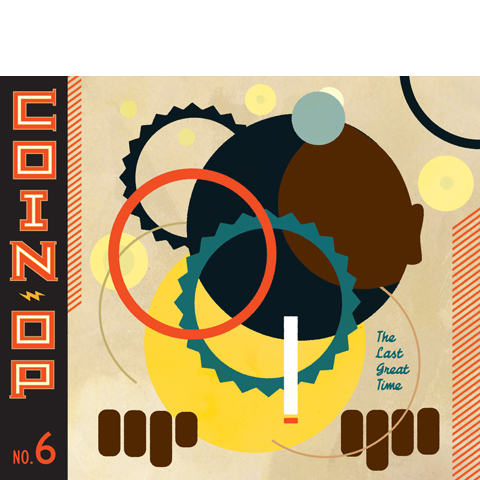Thursday Comics Hangover: Paper cinema

Last year, I wrote about Coin-Op, a wonderful comic series by the brother-sister team of Peter and Maria Hoey. The sixth issue of Coin-Op, titled “The Last Great Time,” was published earlier this summer, and it’s official: Coin-Op is the most wonderful new comic series you haven’t heard about yet.
When they’re not working on their comics, the Hoeys are animators and film buffs, and most of “The Last Great Time” is given over to an exploration of film history, in the form of brief comics essays about Luis Buñuel and Nicholas Ray, with guest appearances from Jimmy Stewart, James Dean, Lauren Bacall, Natalie Wood, Alfred Hitchcock, Jim Jarmusch, and many more. In “The People Vs. Nicholas Ray,” the center strip of every page is given over to a single black-and-white narration of Ray’s work (he’s the director of, among other films, Rebel Without a Cause) in his own words, while the top and bottom of the page feature “testimonials” by celebrities who worked with Ray, telling anecdotes about his life.
The Hoeys use the comics page in unique ways: the entire Coin-Op series is laid out horizontally, which allows the film-history essays to emulate some of the cinematic tricks that Ray uses: wide shots of the Hollywood Hills, interspersed with moody close-ups. It’s a kind of artistic payback: the strip quotes Ray as saying he would talk to film editors to learn his craft and “I’d bring along ‘Steve Canyon’ and ‘Terry and the Pirates’ comic strips as reference. I’d point to one of the strips and ask why can’t we do this the way they do in the comic strips?” Why, indeed.
One of the shorter stories in “The Last Great Time” is a strip featuring Saltz & Pepz, two recurring Coin-Op characters who resemble figures out of early animation. They’re stuck on a handcar, pumping their way down an endless stretch of train track that is, we’re told, “embedded on the surface of a video cassette tape.” They’re ghosts of film history trapped on an outdated form of viewing technology, but they’re still doing their schtick, getting a rise out of each other and pumping away on the handcar in the hopes that something will happen. It’s something like film purgatory, and the way the Hoeys depict the endlessness of their situation is impeccable: the rhythm of two figures pumping up and down on the rails gives the comic a tick-tock precision, a sense that it could go on that way forever.
Even though the first story in the volume, the second part of an ongoing narrative titled “The Inter-Office Memo,” doesn’t have an overtly cinematic angle, it’s still interested in the same questions as film. A man walks down a hallway of cubicles as office workers talk on the phone to unnamed figures. The hallway fills with water and becomes a river, and still the people on the phones keep talking. Every word balloon refers to a number: “At this point, I’m authorized to rebate up to four percent off the sticker price…yes, four percent.” And: “We currently have eleven outlets in your area.” And: “We’re going to need you to resubmit the form. Yes, all nine pages.”
The dreamlike panorama of “Inter-Office” expands further and further until the unconventional panel layout reveals itself: Every page consists of round central panels broken up into a kind of stained-glass tableau that, by the end, reveals itself to be a human eye. The page is looking at you looking at it, and reflected in the iris is a film projector, pointed right at us. Are we watching a movie? Is it watching us? Is there any difference between a flat screen with a movie projected on it and a flat surface with a story printed on it? Doesn’t the difference between comics and film really just come down, in the end, to a question of time?